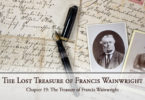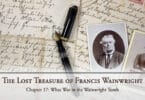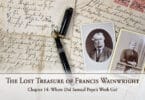The lawyer paused, looking up to make sure the Willick grandchildren were listening. He’d read this letter years ago when Mrs. Willick gave it to him for safekeeping and knew just how important its contents were to all their futures. He needn’t have been concerned. All five young people looked toward him expectantly, rapt with attention. The fact that something special had been set aside in their beloved grandmother’s will, just for them together, was having an almost hypnotic effect on them; they were hanging on his every word.
“Good. This was how it should be.”
Returning his eyes to Mrs. Willick’s letter, he pushed his wire-rimmed glasses back up on his nose and continued.
Francis Wainwright was my 7x great-grandfather, which makes him your 9x great-grandfather. Though he died in Salem the same year of the witchcraft trials, indeed a mere month before the first execution took place, he was lucky enough not to be caught up in that infamous incident. Oh no, my dear grandchildren, no villain was he. Francis was, in fact, a celebrated war hero, famous in the Massachusetts Bay colony in his own time.
He was one of the original English settlers of Massachusetts, coming in an early wave of the Great Migration. Born in approximately 1616 in Chelmsford, Essex, England, he immigrated to Ipswich, Massachusetts in 1630 with Alexander Knight, a merchant with whom Francis was under an apprenticeship at the time. He learned the merchant trade
well, and had just struck out on hisown, when fortune presented this remarkable young man with a unique opportunity to distinguish himself. This opportunity was the beginning of the Pequot War.Francis was only 21 years old at the time, and he volunteered his military services to fight the local Natives who wanted the English off their land. Whether this cause was right or wrong is not important to our story, and best left to others to debate. Our focus is on Francis, and how he built his reputation and gained such respect among his English immigrant peers. He exemplified extraordinary bravery in this war, bravery which became the stuff of legend in Ipswich. At one point in the conflict, he was besieged by two Natives at once, and his gun broke while he was fighting them. In those days, bullets had to be loaded into a gun one shot at a time. Having no time to re-load, Francis used the gun itself as a weapon, bludgeoning his assaulters with it, and killed them all on his own. That story was told and re-told in the community for generations, and is still handed down in his family, just as I am handing it down to you.
He fought against Natives twice more, once in 1642 and again as a Corporal in 1664. In between Native battles, Francis was building his merchant empire, and gaining the respect of Ipswich. He was a voter, something that was reserved only for wealthy male landowners at the time. He bought and sold property, signed a loyalist petition, and was promoted from Commoner to Freeman, an important distinction in the 17th century in New England. The Freeman designation, which was bestowed on him in 1671, essentially meant he was now considered a gentleman.
He married twice. His first marriage was to Philippa Sewall, daughter of George Sewall of Hasted, Essex, England. When she died in 1669, he re-married to Hannah Hicks, who survived him, and who later went on to marry Daniel Epes. He had eight known children, all with Philippa, including our own ancestor, Francis Wainwright, Jr.
When Francis died suddenly while on business to Salem in 1692, the entire Essex County area was stunned. Though he was approximately 76 years old at the time, Francis was still hale and hearty, robust, energetic, strong, and in seemingly perfect health. He was buried in a large tomb in the Ancient Burying Ground in Ipswich, one of the largest ones there from the 17th century.
Francis was quite wealthy when he died, having made a considerable fortune in the merchant business. While he left goodly sums of money and property to all his children, it seemed to many that a large portion of his supposed fortune was unaccounted for, something his children confirmed. According to his son, Simon, Francis buried more than half of the gold he owned somewhere on his farm’s land, for safekeeping. There was supposed to be a map to its location, but no one was ever able to find it, though his children looked in every conceivable place for it. The children kept most of the land in the family for as many generations as they could, and his grandchildren began digging up the land in search of the supposed lost treasure. Each generation passed on the story to the next, and each generation duly did their own searching. It has been more than 300 years since Francis Wainwright died, and that treasure has never been discovered. Yet, we who are his direct descendants still believe it is there.
My own grandmother told me she and her cousins did not believe the treasure was actual gold, but something far more valuable. What that might be, she had no idea, but the story had been handed down to her from her own grandmother that Francis’s treasure was something that was personally special to him and important to the family, and that he let the rumor be of missing gold before he died to throw anyone but the truest, most loyal family members off the trail of the real treasure. I believe this version of the story.
As my siblings, cousins, and Iwere not able to find the treasure, like the six generations before us, I leave the task to you, along with your first clue to get you started. May you be the generation who is finally victorious in discovering the treasure Francis Wainwright kept so carefully, lovingly hidden, even from his own children.Your loving grandmother always,
Martha Jane Willick.
“Guys, we need to find this treasure. For Grandma,” Christine, Mrs. Willick’s eldest grandchild said softly, not taking her eyes off the note in the lawyer’s hands.
“Agreed,” Emily, the youngest, affirmed, nodding. “So, where is the clue.”
The lawyer carefully put down the note and lifted the ancient daguerreotype once more, holding it aloft so they could all see it.
Pointing to the elderly woman in 1850’s finery looking sternly into the camera from so long ago, he smiled.
“It’s right here. Allow me to show you.”
CONTINUED IN CHAPTER 3






